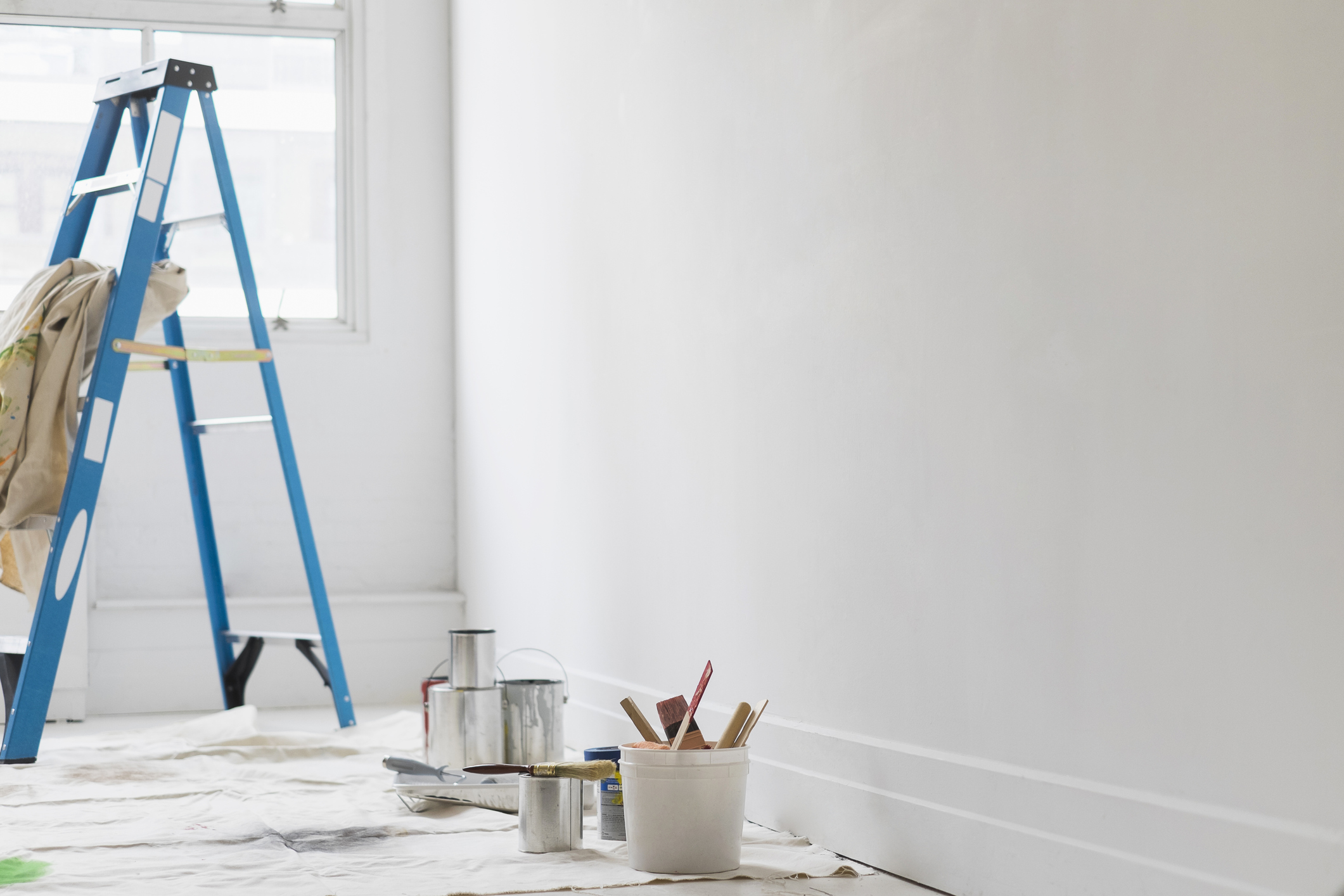How to paint over wallpaper – an expert guide
Painting over wallpaper can be done, saving time and effort. Here’s how

Wondering if painting over wallpaper to change the look of a room is possible?
Contrary to popular belief, you don’t have to know how to remove wallpaper in order to redecorate – painting over wallpaper can save time, effort and money if done right. And it doesn’t mean sacrificing a good quality finish, either.
It’s all about the prep work, according to Ruth Mottershead, creative director at Little Greene. ‘Good preparation will make a huge difference to the quality of your finished project,’ she says. ‘Do it the night before you plan to decorate, so you can easily apply two coats and have the room finished in one day,’ she says.
How to paint over wallpaper
Painting over wallpaper is as easy as learning how to paint a wall in theory. However, there are a few extra steps you should take to avoid disappointing results, as well as any further surprises further down the line.
These steps plus top tips from the experts explain what tools and techniques to use for a professional finish.
Is painting over wallpaper a good idea?
If you ask industry experts how to paint over wallpaper, chances are they’ll advise against it. As a general rule, removing old wallpaper and, if you want to replace it, learning how to wallpaper, is the better route to go down – however, it does have downsides.
‘When removing wallpaper, there’s a chance you could damage the wall beneath, particularly if you have an old house,’ says Aaron Markwell, color lead at COAT. ‘It can take ages to remove if faced with layer upon layer, so painting is often the best course of action.’
If time is of the essence, painting over wallpaper is your best bet. However, there are scenarios when removing wallpaper is essential, regardless. ‘If it’s peeling in multiple places for example, or if there’s any sign of mold,’ says Aaron. ‘If it’s the latter, you’ll also need to find and fix the cause – don’t just paint over it.’
1. Clean the walls
The first thing you’ll need to do is give the wallpaper a wipe with a damp cloth. ‘If there's dirt or dust in the wallpaper the paint won't stick properly and will peel off later,’ says interior designer and professional painter Tony Adams of DIY Geeks. He recommends using a diluted solution of TSP, particularly if the walls are greasy, but a mild detergent solution works well, too. Be sure to let the walls dry thoroughly.
2. Ensure an even surface
The cleaning process is a good opportunity to locate any uneven surfaces and make any necessary repairs.
‘Check for cracks, screw holes, seams and imperfections and use filler where needed. Where there have been repairs, sand them down smooth so that the area looks seamless when painted,’ says Ruth.
If wallpaper is peeling or coming away at the edges, use adhesive to seal them down. Don’t be tempted to just paint over problem areas – it’ll only result in problems further down the line and potentially costly repairs.
3. Cover the seams
‘If the wallpaper has overlapping seams, peel them off with a putty knife, then fill the gaps with a joint compound. Allow it to dry, then sand again to create a smooth surface,’ says Jan Walter, founder of Gocolourize .
4. Use a primer
Next, apply a primer to the walls. This ensures a smooth, white finish which is much easier to paint on to and results in a better quality finish. An oil-based primer is the best way to go. ‘A water-based one will soak into the wallpaper and weaken the glue,’ says Tony. This can result in the paper bubbling or coming away from the wall, neither of which is ideal.
If you’re hiding a particularly colored or patterned print, consider painting over the primer again with a white matte emulsion.
5. Apply at least two coats of paint
When the primer is completely dry, apply the top coat. The process is the same as when painting a wall; start in the corner and paint in horizontal bands from top to bottom.
‘When it comes to the must-have tools, a firm favorite amongst consumers is to use a roller for painting walls and a 2 in brush for cutting in around the edges. To ensure a smooth finish, a microfiber roller sleeve is best,’ says Helen Shaw of Benjamin Moore.
For best results, you’ll need to apply a second coat of paint, particularly if the wallpaper underneath was brightly colored or patterned.
What kind of paint do you use to paint over wallpaper?
If you’ve covered your wallpaper with an oil-based primer, you can use any type of paint over the top – good quality paints are preferable. Never use a water-based primer as it can cause the wallpaper to bubble or become loose over time.
Can you paint over any wallpaper?
In theory, yes, as long as it’s not fabric-backed vinyl. However, the quality of finish will differ depending on what you’re covering, which might affect your decision. ‘If you’re unsure, you may want to test a small area first to see how the paint reacts to the surface – particularly if the wallpaper is shiny,’ advises Ruth.
Textured wallpaper can be hard to remove, so painting over can be tempting. However, it’s likely to show through the paint, which isn’t a great look. It’s possible to skim over it, but that’s a job for a professional, and usually requires taking off the wallpaper anyway.
Sign up to the Homes & Gardens newsletter
Design expertise in your inbox – from inspiring decorating ideas and beautiful celebrity homes to practical gardening advice and shopping round-ups.
For 10 years, Tara King worked as a Content Editor in the magazine industry, before leaving to become freelance, covering interior design, wellbeing, craft and homemaking. As well as writing for Ideal Home, Style at Home, Country Homes & Interiors, Tara’s keen eye for styling combined with a passion for creating a happy – and functional – family home has led to a series of organization and cleaning features for H&G.
-
 'Wick away the ick' – 6 things people with clean laundry rooms always do to make this hardworking space shine
'Wick away the ick' – 6 things people with clean laundry rooms always do to make this hardworking space shineThese tips on how to clean your laundry room will banish grime
By Seraphina Di Mizzurati Published
-
 Jennifer Aniston’s bedroom is a ‘goldmine of simple sumptuousness’ – it’s 2025’s version of quiet luxury and so easy to recreate
Jennifer Aniston’s bedroom is a ‘goldmine of simple sumptuousness’ – it’s 2025’s version of quiet luxury and so easy to recreateThe actress's unique space features James Mont-designed lamps and a raised bed inside a walnut plinth – but you can recreate its understated sophistication
By Megan Slack Published
-
 7 dorm room organizing rules for less clutter and more space
7 dorm room organizing rules for less clutter and more spaceExperts offer their top tips for creating a well-organized dorm room, no matter the size, space, or layout.
By Ashley Chalmers Published
-
 How to maximize storage in a small or shared dorm room, according to pro organizers
How to maximize storage in a small or shared dorm room, according to pro organizersFind out all the hidden storage zones you might never have noticed
By Ashley Chalmers Published